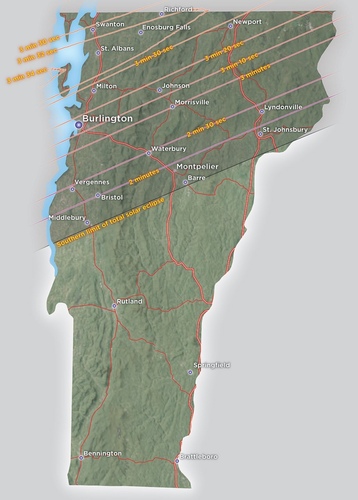Do you have Monday, April 8, circled in red on your calendar?
Just in case you are someone who isn't excited about the upcoming total solar eclipse, I want to make sure you know why you should be. If you have seen lunar eclipses and partial solar eclipses, you might think April 8 will be similar. Consider this: the sun is so bright that even a 90% eclipse could go unnoticed if you weren't watching for it.
That is not the case with a total solar eclipse.
I first became aware of how different this experience might be when I read Annie Dillard's essay "Total Eclipse." Dillard is a Pulitzer Prize–winning writer best known for her poetic and keen observations of the natural world. Here is her description of the light just before totality:
"The sun was going, and the world was wrong. The grasses were wrong; they were platinum. Their every detail of stem, head, and blade shone lightless and artificially distinct as an art photographer's platinum print. This color has never been seen on Earth. The hues were metallic; their finish was matte."
I was intrigued, but because Annie Dillard can find the majestic in the mundane, I have begun looking for accounts by ordinary mortals as well. All recount a similar feeling of otherworldliness and awe.
* * *
Here are the recommendations I have gleaned.
First, get yourself to the zone of totality. In Vermont, the southern reach of that 70-mile-wide band runs just below Middlebury, Barre, and St. Johnsbury. The closer you are to the middle of the band, the longer totality lasts. At the southern limit, it will last for just two minutes. You can add another minute and a half by driving a bit farther north.
From Brattleboro, you can drive straight up Interstate 91 for 2.5 hours to the Canadian border town of Newport. You'll want to choose a spot with a big view of the sky. The Vermont eclipse will begin (depending on your longitude) near 2:15 p.m., with totality achieved at 3:30 p.m. The moon's shadow will depart an hour later.
Veteran eclipse chasers' advice to first-timers is to just soak it in. Don't try to take photos. Totality is short and rare. There are, however, a few things worth watching for.
The strangeness begins several minutes before totality, when it begins to darken noticeably and only the very edge of the sun illuminates the Earth; look for the phenomenon Dillard describes. Shifts in the light spectrum and within our eyes result in the world taking on a silvery cast. Certain features, especially shadows, take on an uncanny crispness.
At the moment of totality, you can remove eclipse glasses and feast your eyes. The mountains along the edge of the moon will flash with sunlight in a phenomenon called Bailey's Beads. The sun's corona will form a silvery band around the black disc of the moon and may appear as silky strands reaching into space. If the sun ejects plasma, the Diamond Ring effect will be seen.
The sky will darken to an indigo blue, and the planets and brightest stars will appear. With the sun and the planets arrayed along the same arc, Earthings will have a glimpse of the order of our solar system. On April 8, Uranus and Jupiter will be above the sun; Venus, Saturn, and Mars will be below it.
There is a 60% chance that skies will be cloudy on April 8. I will plan to head to the zone of totality anyway, just to see the sky grow dark in midafternoon.
If you're thinking you'll just wait for the next total solar eclipse to come to Vermont, you'll have to wait until 2106.
* * *
It's true that the eclipse will last only a few minutes, but how often do we have opportunities to experience perspective-altering awe?
Here's another reason to go see the eclipse - intense shared experiences have been shown to build feelings of trust and camaraderie.
Maybe, if all of America sees the eclipse together?
It's worth a try.
* * *
If you want to learn more eclipse science and celebrate the solar system, the Bonnyvale Environmental Education Center will be hosting "Summoning the Eclipse" on Saturday, April 6 from 1 to 3 p.m.
You can register for this family-friendly event at beec.org or by calling 802-257-5785. Admission includes eclipse glasses, an essential part of eclipse-watching gear.
Patti Smith is a wildlife rehabilitator and naturalist at the Bonnyvale Environmental Education Center in West Brattleboro. The Commons' Deeper Dive column gives artists, arts organizations and other nonprofits elbow room to write in first person and/or be unabashedly opinionated, passionate, and analytical about their own creative work and events.
This News column was submitted to The Commons.
